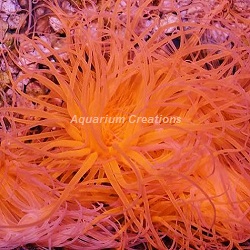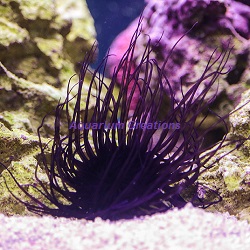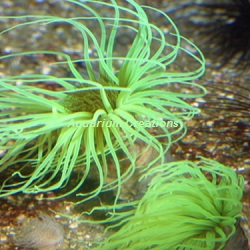
|
|
|
|
|
|
|
|
|
|
Tube Anemone
|
|
|
|
|
|
|
|
|
|
| Tube Anemone, Cerianthus membranaceus, is also called the Tube Dwelling Anemone, or the Colored Tube Anemone. It comes in different highly variable color's which range from white, peach/orange, purple and neon green. Being both colorful and hardy, they are prized for an aquarium display. This durable animal can tolerate a fairly wide temperature range, subdued lighting, and moderate filtration. |
| Orange Tube Anemone starting at $59.99 |
Purple Tube Anemone starting at $59.99 |
Neon Green Tube Anemone starting at $59.99 |
|---|---|---|
 |
 |
 |
|
Description:
Tube Anemone have a long, soft, cylindrical body. The body is topped with a crown of tentacles on one end that cannot retract, and a pointed foot on the other end. It uses its pointed foot to burrow deep into a sandy or muddy substrate, leaving only the oral disc and tentacles exposed on the surface. Once in the substrate, the Tube Anemone constructs a hard tube to live in. They create their tube by releasing threads of a special type of nematocysts called 'ptychocyst'. The result is a woven fibrous structure. Though its tentacles are non-retractable, if it is frightened or disturbed it can instantly withdraw its whole body into the tube and become hidden.
Tank Recommendations: Since tube anemone are non-photosynthetic (not fed by photosynthesis through light), they do not require intense lighting. Any lighting is fine. Several Tube Anemone specimens can be kept in an aquarium, but they are not compatible with other anemone species. The typical reef environment with a 4 inch or deeper sand bed, with enough depth to accommodate its total length. Hitting a bare bottom, as well as trying to burrow through course gravel (rice sized or larger), will prevent the C. membranaceus from finding a spot to burrow and settle. This can cause them to stress and not do well. Food and diet: The Tube Anemone is a carnivore and will generally accept small meaty foods in captivity. It can be offered finely minced krill, fish, shrimp and/or frozen brine or mysis shrimp. Be careful not to feed with large pieces since they will damage their delicate tentacles. This anemone is nocturnal so feed after the main lights go out or when they emerge from there tube. If you have a lot of copepods, amphipods, or other small prey in the tank, then feed twice a week, otherwise feed daily. Level of Care: Moderate Reef Compatibility: with caution Approximate Inflated Size: Small: 2" to 3" Medium: 3" to 4" Large: 4" to 8" |
|
|
|
|
|
|
|
|
|
|
|
Copyright 2018 Aquarium Creations Online Photos are representative of each species. Due to variations within species, your item may not look identical to the image provided. All marine life will be unique and variations should be expected, color and sizes may vary. *Recommended for: Expert aquarist, Zoo, or Research center: All of our livestock has a guarantee to arrive alive. However for species recommended for either Expert aquarist, Zoo, or Research center we cannot offer a guarantee beyond 2 hours after arrival for one or more reasons outlined below. This means the specific animal may not handle stress from environmental conditions well. These stresses can include poor water quality, harassment from tank mates, harm from pump intakes, or confined aquarium conditions. When stressed, these species can lose the ability to ward off infection and disease. Other species may be listed as Restricted because they have such specialized feeding requirements that is difficult to recreate in a aquarium and may succumb to malnutrition. |